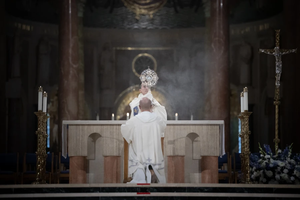Praying Like a Monk: The Liturgy of the Hours as a Family
This liturgical form of prayer draws us closer to God throughout the day, uniting us with clergy, religious and laity around the world in the praise of God.

Recently, our family had the opportunity to spend a day with our dear friend who is a monk and other families. He was visiting his parents and set aside a day to spend with his college friends. As we joined him in praying multiple hours of the Divine Office, I felt even more drawn to the practice of praying this liturgy of the Church more often — to pray like a monk whose life images how we will all live in heaven — even just once a day.
My family makes Night Prayer part of our routine.
The familiar words wash over my children as we recite the stanzas from the Psalms of Night Prayer back and forth from one side of the room to the other. They do not even need to look at the words, as they have become a part of their spiritual memory over our years of praying the final hour of the day from the Liturgy of the Hours as a family.
Our family custom of sharing in this “public prayer of the Church” has truly been a “source of piety” and “nourishment for personal prayer” for us, and it is practice worth doing in every household (Sacrosanctum Concilium 90).
The Second Vatican Council also explains in Sacrosanctum Concilium that the Divine Office is a “tradition going back to early Christian times” and “is devised so that the whole course of the day and night is made holy by the praises of God.” It is “the voice of the bride addressed to her bridegroom,” and further it is “the very prayer which Christ Himself, together with His body, addresses to the Father” (SC, 84).
As the Psalms, readings and other parts of the Divine Office are drawn from the words of Scripture, the General Instruction of the Liturgy of the Hours explains that those who pray it “have access to holiness of the richest kind” (III.14). Further, those who pray it join in the praise of God with the Church in heaven, enter together in petition and intercession, and are strengthened in their apostolate in whatever state of life. When listing who should pray the Divine Office, the General Instruction mentions the family as “the domestic sanctuary of the Church” who should “not only pray together to God but should celebrate some parts of the Liturgy of the Hours as occasion offers, so as to enter more deeply into the life of the Church” (III.27).
The wording of celebrating “some parts of the Liturgy of the Hours” is a kind of grace for families. Our clergy and religious are doing a sort of spiritual battle on our behalf in these hours of prayer while we go about in our vocations. And then we have the opportunity to tap into their shared prayer, into the life of the Church, as we are able.
Prayer in family life changes depending on the various seasons. There are the liturgical seasons of the year, as we do special prayers for Advent, Lent and Easter. And there are also the phases of life, such as when all the children were little and we decided to only pray the family Rosary in the car so that none of the children could escape from their seats. Then there was the season when the children stopped napping so I gave up on taking my silent prayer time alone and invited my children to join me in the same room doing their own silent prayer.
Similarly, our family’s participation in the Liturgy of the Hours has changed according to life seasons and schedules. There was once a time when I breakfasted with my husband while the children were still asleep. Rather than holding a groggy conversation before coffee, we would prop open a breviary between us and pray Morning Prayer in silence. Our phase of life shifted, and the Liturgy of the Hours dropped out of our morning. We then added it to our bedtime routine, taking five to 10 extra minutes before bed to pray the Divine Office as a family. More recently, my husband and I have found a new rhythm of praying one or two hours together during the day, as we both work from home. We have found this liturgical form of prayer draws us closer to God throughout the day whenever we take the time to pray it, uniting us with clergy, religious and laity around the world in the praise of God.
There are many resources available to aid us in the prayer of the Divine Office, from apps, to websites, to physical breviaries. The website Catholic Apptitude lists all of the online possibilities of praying or even listening to the Liturgy of the Hours. Printing off the whole week of Night Prayer and putting it in folders with brackets is completely doable. Or pulling up the prayers on multiple phones and devices while one person holds a breviary also works. For our family Night Prayer, we have folders, but if we do another hour, we have been known to gather around one book together.
Praising God with the words of Scripture is a taste of being together in our heavenly home, before him, loving him together with all of those we are separated from by distance and by death.
Let us all make the Liturgy of the Hours a more regular part of our prayer life and prepare our hearts for heaven.
- Keywords:
- liturgy
- liturgy of the hours

















